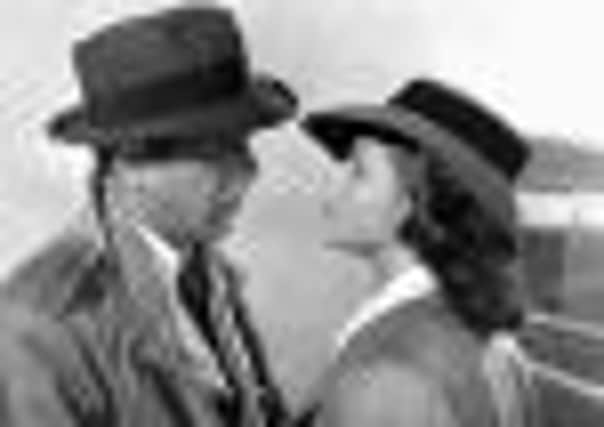How an enduring classic was born – against all the odds


“You must remember this; a kiss is just a kiss…”
What do you mean, you’ve never seen Casablanca? In the pantheon of truly great Hollywood pictures it is up there with the very best. There are those who declare it to be a perfect movie. And on its release in 1942 it seemed to tap into a mood that, on both sides of the Atlantic, hinted at what ordinary people could do when they rose to the challenge.
A sentimental melodrama set against the backdrop of war, it focuses on refugees desperately seeking a route to freedom through Casablanca. The central hub for the action is Rick’s Café Américain run by a former soldier of fortune who has grown weary of smuggling and fighting.
Advertisement
Hide AdAdvertisement
Hide AdCasablanca is a movie surrounded by myth, half truths and outright lies. So much has been written about it that, eight decades later, it is hard to separate wheat from chaff. What is certain is that, in 1942, Humphrey Bogart had elbowed aside rivals such as George Raft, James Cagney and Edward G Robinson to snag a place at the top table of movie gangsters. He wasn’t about to give up that hard-won tough guy image to play a hero with a soft centre and a weakness for dames.
Yet Rick Blaine, taciturn anti-hero and confirmed neutral observer (“What is your nationality?” “I’m a drunkard.”) would present Bogart with arguably his most enduring screen characterisation.
Realigning Bogart’s image as a laconic Romeo had the actor worried. Around the time that he was being sought for Casablanca, studio publicists at Warner Bros tagged him as the man with ‘Biv’. When Bogart queried the tag with press agents he was told it stood for ambivalence. It was a clunky way of realigning his film persona in light of the role he was about to play.
Several tales surround the casting of the various leads and supporting artistes in Casablanca. Ingrid Bergman landed the part of Ilsa Lund only after producer David Selznick turned down all other work, hoping to secure for her the role of Maria in Ernest Hemingway’s For Whom the Bell Tolls. When she was passed over, Bergman found herself out of work and depressed. Then she was offered Casablanca, and Selznick let her do it.
Advertisement
Hide AdAdvertisement
Hide AdThe twist in the tale is that Ilsa wanders into Rick’s bar, and back into his life, after leaving him standing on a Paris railway station in 1940. Their reunion is a bittersweet one and Rick struggles with Ilsa’s confession that the husband she thought was dead, underground leader Victor Laszlo (Paul Henreid), was in fact still alive.
He is with her in Casablanca. Together they hope to escape to neutral Lisbon. And they need Rick’s help. But that’s only part of the intrigue in Casablanca. The film is packed with all manner of interested parties from Nazi officers, to corrupt captains of police, desperate couriers, crooks, Quislings, refugees and “tourists”. Key to the multi-threaded plot was the simmering romance between Rick and Ilsa. The Bogart-Bergman combination was pure box office gold.
Casablanca was adapted from a play, Everybody Comes to Rick’s, by brothers Julius and Philip Epstein who, famously, only worked for two hours a day. This led to furious stand-offs with studio chief Jack Warner. Often the Epsteins only delivered material needed for the next day’s filming. Thus it was that Bogart, Bergman and others later claimed they had no idea what the film was about or where it was going. If the Epsteins supplied the dry wit, Howard Koch added weight to the story’s political dimension. Casey Robinson, scribe of women’s films like Dark Victory, created the romance. When filming began on May 25, 1942, there was no completed script. Up to the eve of shooting both Bergman and Bogart were unhappy about the production and wanted out.
Observers claimed there was little chemistry between them – perhaps explained by the fact that Bogart did not have an affair with his predatory leading lady, who had a reputation for bedding her leading men. Paul Henreid joined the film a month late. By the time he entered the café in his white suit director Michael Curtiz had shot as much as he could around him. He arrived just in time.
Advertisement
Hide AdAdvertisement
Hide AdCasablanca coalesced into a classic despite a constantly changing script and the variable temperament of the autocratic Curtiz, who stomped about in riding boots. The film’s heart-stopping finale involved Bogart delivering a four-page monologue which had been handed to him the night before. But he did it. The film wrapped on August 3 and a classic was born. Casablanca went on to win three Academy Awards including Outstanding Motion Picture, Best Director and Best Screenplay. Bogart, nominated as Best Actor, was passed over; he won in 1952 for The African Queen.
But it’s for Casablanca that Humphrey Bogart is best remembered: a trench-coated anti-hero standing in the rain, turning and uttering that immortal closing line: “Louis, I think this is the beginning of a beautiful friendship.”
Casablanca (U) is re-issued in cinemas this week.